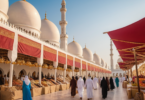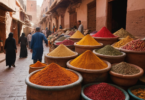Morocco, a land of captivating landscapes, vibrant cities, and a rich history, offers a window into ancient traditions that have shaped its identity over centuries. The country’s culture is an intricate blend of Arab, Berber, and European influences, creating a unique mosaic that spans from the deserts of the south to the shores of the Mediterranean and Atlantic coasts. A cultural journey through Morocco reveals a world of timeless traditions, artistic craftsmanship, and spiritual practices that continue to thrive in the modern age. Whether it’s exploring ancient souks, engaging in traditional craftsmanship, or experiencing unique rituals and festivals, Morocco offers a profound glimpse into its cultural legacy.
1. The Ancient Art of Moroccan Crafts
Moroccan craftsmanship is deeply rooted in the country’s ancient traditions. From intricate tile work to woodworking, these arts have been passed down through generations, representing the soul of Morocco’s diverse cultures.
Zellige: The Traditional Moroccan Tilework
One of the most iconic aspects of Moroccan craftsmanship is zellige, the art of creating mosaic tiles. Zellige is often seen decorating the walls, floors, and fountains of palaces, mosques, and public spaces. The tiles are made from clay and hand-cut into geometric patterns that are arranged without the use of mortar, showcasing the skill of Moroccan artisans. Cities like Fez and Marrakech are known for their intricate zellige, and visitors can observe artisans at work in the many workshops throughout these cities.
Leather Tanning in Fes
Another ancient Moroccan tradition is the art of leather tanning, particularly in the city of Fes. The Chouara Tannery in Fes is one of the oldest in the world, where leather is dyed using natural methods in large vats filled with vibrant colored dyes. This method, which dates back to the 11th century, is a fascinating process to witness, and visitors can walk through the tannery to observe workers handcrafting leather goods like bags, shoes, and jackets using time-honored techniques.
Berber Carpets: Woven Heritage
Berber carpets, woven by the indigenous Berber people of Morocco, are another reflection of the country’s rich heritage. Each Berber carpet tells a unique story through its designs, often representing symbolic meanings related to family, nature, and spirituality. These carpets are handwoven using natural dyes and wool, and visitors can find them in markets throughout Morocco, especially in cities like Marrakech and Rabat.
2. The Role of Music in Moroccan Culture
Moroccan music is as diverse as its culture, influenced by Arab, Berber, African, and Andalusian traditions. Music plays a vital role in Moroccan life, accompanying rituals, festivals, and social gatherings. The country’s unique blend of sounds reflects the spiritual and cultural practices of its people.
Gnawa Music: A Spiritual Journey
One of the most well-known musical traditions in Morocco is Gnawa music, a deeply spiritual genre that blends African, Berber, and Arab influences. Gnawa music is often performed during ceremonies and rituals meant to heal, celebrate, or invoke spiritual experiences. The music is characterized by the use of large drums, metal castanets (known as qraqeb), and the lute-like gimbri. Festivals like the Gnaoua World Music Festival in Essaouira celebrate this unique musical tradition, drawing visitors from around the world.
The Andalusian Influence: The Sounds of Al-Andalus
Another important element of Moroccan music is the Andalusian music tradition, which has roots in the period of Al-Andalus (medieval Spain) and was brought to Morocco by the Muslim rulers and refugees fleeing the Iberian Peninsula. This classical music style is performed with lutes, violas, and flutes and is often heard in Moorish gardens and palaces across Morocco, especially in Marrakech and Fez.
Traditional Festivals: Music and Dance
Moroccan festivals are a celebration of the country’s cultural diversity, with music and dance at their core. The Moussem of Tan-Tan, held annually in southern Morocco, is an important festival that honors traditional Berber music, dance, and poetry. In Marrakech, the Festival of Popular Arts showcases a rich blend of traditional music, folk dancing, and storytelling.
3. Religious and Spiritual Traditions in Morocco
Religion and spirituality are central to Moroccan life, with Islam playing a dominant role in shaping cultural practices. However, Morocco’s deep respect for spirituality also extends to its indigenous Berber traditions and the Sufi practices that have influenced Moroccan mysticism.
The Rituals of Ramadan
Ramadan, the holy month of fasting, is one of the most significant religious events in Morocco. During this time, Muslims fast from dawn to sunset, focusing on prayer, reflection, and community. The evenings are marked by the iftar meal, where families gather to break their fast with dates, soup, and traditional Moroccan sweets. The month ends with the celebration of Eid al-Fitr, a festival of feasts and charity, marked by vibrant public celebrations across the country.
Sufi Mysticism and the Art of Whirling
Sufi mysticism is another integral part of Morocco’s spiritual heritage. The dervishes, who perform the whirling dance, use movement as a form of meditation and connection with the divine. The Zaouia Moulay Idriss, located in the city of Fez, is a spiritual center where Sufi practices are celebrated through poetry, chanting, and ritualistic dances. Visitors can witness these profound ceremonies, which symbolize the Sufi’s journey toward spiritual enlightenment.
Mausoleums and Shrines: Pilgrimages to Sacred Sites
Morocco is dotted with mausoleums and shrines dedicated to saints, prophets, and religious figures. Many Moroccans embark on pilgrimages to these sacred sites, seeking blessings and spiritual guidance. The Mausoleum of Moulay Ismail in Meknes and the Shrine of Sidi Bel Abbas in Fes are among the most revered.
4. Traditional Moroccan Cuisine: A Feast for the Senses
Food in Morocco is more than just sustenance; it’s a reflection of the country’s cultural and historical tapestry. The art of Moroccan cuisine combines a variety of spices, fresh ingredients, and ancient cooking techniques that have been passed down through generations.
Tagine: A Culinary Tradition
One of the most iconic Moroccan dishes is tagine, a slow-cooked stew made with a variety of ingredients like lamb, chicken, vegetables, and dried fruits, all seasoned with a mix of saffron, cumin, and cinnamon. The name “tagine” refers to the special clay pot in which the dish is cooked, a cooking method that helps to preserve flavors and nutrients. Tagine is often served with khobz (Moroccan bread), which is used to scoop up the food.
Mint Tea: A Symbol of Hospitality
Another essential element of Moroccan culture is mint tea. The serving of tea, made with fresh mint and green tea leaves, is an important tradition that symbolizes Moroccan hospitality. It’s common for families to offer tea to visitors as a gesture of welcome and respect. In many souks and cafes, tea ceremonies are performed with intricate rituals, involving the pouring of the tea from a height to create a frothy layer on top.
Couscous and Moroccan Pastries
Couscous, made from steamed semolina, is a staple food often served with vegetables and meat. It is typically enjoyed during family gatherings and celebrations. Moroccan pastries, such as baklava and kaab el ghazal, made with almond paste and honey, are a popular treat during religious holidays and special occasions.
5. The Festivities of Morocco: A Celebration of Culture
Morocco is known for its vibrant festivals that celebrate its rich cultural and religious traditions. These festivals attract visitors from around the world, offering a chance to witness the country’s artistry, music, and unique cultural heritage.
Moussem of Tangier: Celebrating Moroccan Identity
The Moussem of Tangier, held annually in the coastal city of Tangier, celebrates Moroccan culture with a series of performances that include music, dancing, and poetry. The festival offers an opportunity to engage with traditional and modern Moroccan art, as well as to learn about the country’s diverse ethnic groups, from Berbers to Arabs.
Festival of Sacred Music in Fes
The Festival of Sacred Music in Fez brings together musicians, dancers, and poets from around the world to perform spiritual and mystical music. The festival’s aim is to promote cultural exchange and understanding through the universal language of music.
Conclusion: A Cultural Tapestry of Morocco
Morocco’s ancient traditions offer a fascinating and immersive cultural journey. From its traditional crafts and spiritual practices to its vibrant festivals and rich cuisine, the country invites travelers to explore its deep-rooted cultural heritage. A journey through Morocco is a journey through time, where the past and present coexist harmoniously, creating a destination that is as rich in tradition as it is in hospitality.







